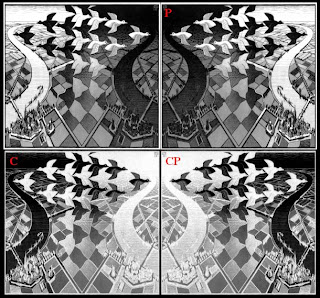Monday, September 6, 2010
What did Escher know?
In the interesting physics colloquium that Marcelo Gleiser gave on friday at UQ he used the Escher print above to illustrate CP symmetry in a system which violates both C and P symmetry.
[C is charge conjugation and P is parity].
I found the image here.
Another example of breaking of a symmetry while conserving a combined symmetry concerns vibronic transitions in molecules. For molecules which have inversion symmetry selection rules suggest that electronic transitions that involve no change in parity should not be observed. However, they sometimes are because they are combined with a vibrational transition. Hence, vibronic [= vib(rational)-(elect)ronic] transitions. I think the first observed case of this may have been in benzene.
Subscribe to:
Post Comments (Atom)
What does learning to ride a bicycle teach us?
How do you learn to ride a bicycle? How do you teach someone to ride a bicycle? It is not easy to put this into words and that is an importa...

-
This week Nobel Prizes will be announced. I have not done predictions since 2020 . This is a fun exercise. It is also good to reflect on w...
-
Is it something to do with breakdown of the Born-Oppenheimer approximation? In molecular spectroscopy you occasionally hear this term thro...
-
Nitrogen fluoride (NF) seems like a very simple molecule and you would think it would very well understood, particularly as it is small enou...




No comments:
Post a Comment